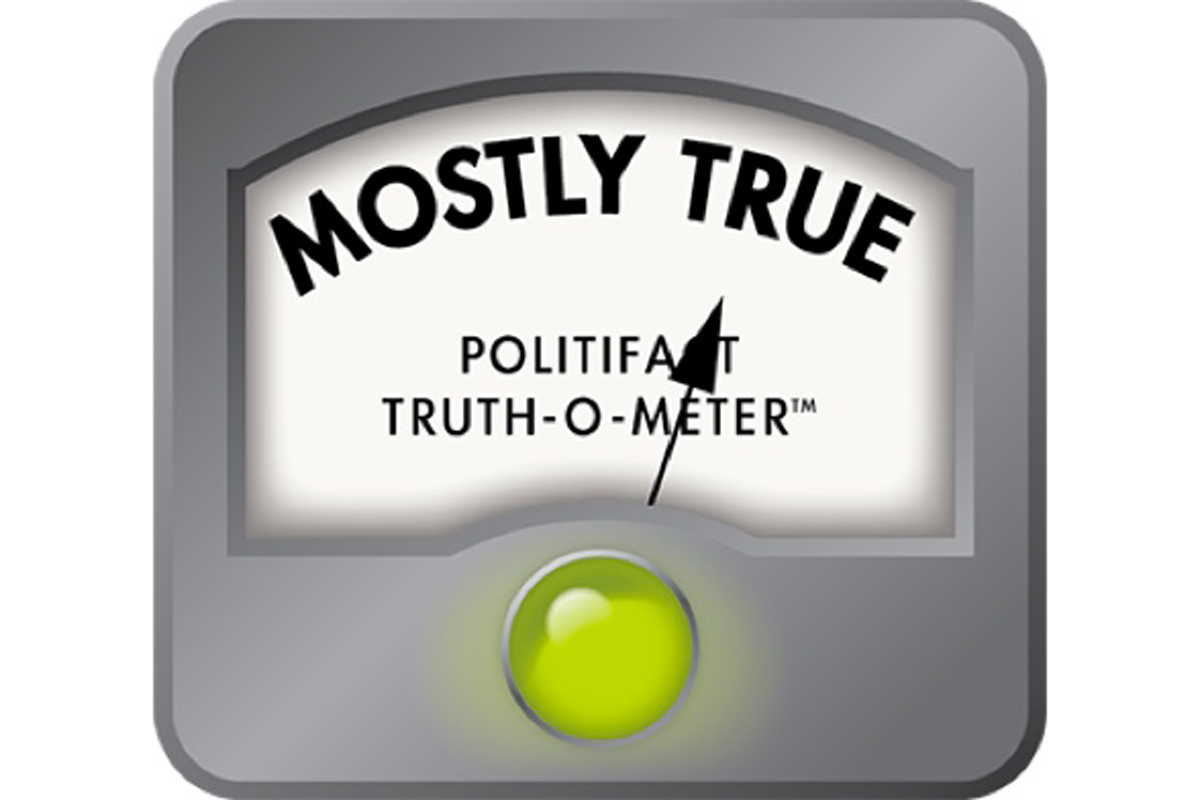If you went “anywhere in the world,” you could get a prescription filled for 40% to 60% less than it costs in the U.S.
Joe Biden on Feb. 22, 2024, at a campaign reception
It’s well documented that Americans pay high prices for health care. But do they pay double or more for prescriptions compared with the rest of the world? President Joe Biden said they did.
“If I put you on Air Force One with me, and you have a prescription — no matter what it’s for, minor or major — and I flew you to Toronto or flew to London or flew you to Brazil or flew you anywhere in the world, I can get you that prescription filled for somewhere between 40 to 60% less than it costs here,” Biden said Feb. 22 at a campaign reception in California.
He followed up by touting provisions in the 2022 Inflation Reduction Act to lower drug prices, including capping insulin at $35 a month for Medicare enrollees and limiting older Americans’ out-of-pocket prescription spending to $2,000 a year starting in 2025. The law also authorized Medicare to negotiate prices directly with drug companies for 10 prescription drugs, a list that will expand over time.
Research has consistently found that, overall, U.S. prescription drug prices are significantly higher, sometimes two to four times as high, compared with prices in other high-income industrialized countries. Unbranded generic drugs are an exception and are typically cheaper in the U.S. compared with other countries. (Branded generics, a different category, are close to breaking even with other countries.)
However, such factors as country-specific pricing, confidential rebates, and other discounts can obscure actual prices, making comparisons harder.
“The available evidence suggests that the U.S., on average, has higher prices for prescription drugs, and that’s particularly true for brand-name drugs,” said Cynthia Cox, director of the Peterson-KFF Health System Tracker, which tracks trends and issues affecting U.S. health care system performance. “Americans also have relatively high out-of-pocket spending on prescription drugs, compared to people in similarly large and wealthy nations.”
Andrew Mulcahy, a senior health economist at Rand Corp., a nonpartisan research organization, agreed that Biden’s overall sentiment is on target but ignores some complexities.
He said price comparisons his team has conducted reflect the amounts wholesalers pay manufacturers for their drugs, which can differ sharply from prices consumers and their drug plans pay.
“In many of those other countries, [patients] pay nothing,” Mulcahy said. “So I think that’s part of the complication here when we talk about prices; there are so many different drugs, prices, and systems at work.”
What International Drug Pricing Comparisons Show
A 2024 Rand study that Mulcahy led found that, across all drugs, U.S. prices were 2.78 times as high as prices in 33 other countries, based on 2022 data. The report evaluated most countries in the Organization for Economic Co-operation and Development, or OECD, a group of 38 advanced, industrialized nations.
The gap was largest for brand-name drugs, the study found, with U.S. prices averaging 4.22 times as high as those in the studied nations. After adjusting for manufacturer-funded rebates, U.S. prices for brand-name drugs remained more than triple those in other countries.
The U.S. pays less for one prescription category: unbranded, generic drugs, which are about 33% less than in other studied countries. These types of drugs account for about 90% of filled prescriptions in the U.S., yet make up only one-fifth of overall prescription spending.
“The analysis used manufacturer gross prices for drugs because net prices — the amounts ultimately retained by manufacturers after negotiated rebates and other discounts are applied — are not systematically available,” a news release about the report said.
People with health insurance pay prices that include both markups and discounts negotiated with insurers. Uninsured people may pay a pharmacy’s “usual and customary” price — which tends to be higher than net prices paid by others — or a lower amount using a manufacturer discount program. But many of these adjustments are confidential, making it hard to quantify how they affect net prices.In 2021, the Government Accountability Office released an analysis of prices of 20 brand-name drugs in the U.S., Canada, Australia, and France. The study found that retail prices were more than two to four times as high as in the U.S.Like Rand, the agency adjusted for rebates and other price concessions for its U.S. estimate, but the other countries’ estimates reflected gross prices without potential discounts.
“As a result, the actual differences between U.S. prices and those of the other countries were likely larger than GAO estimates,” the report said.
Another analysis by the Peterson-KFF Health System Tracker that Cox co-authored compared the prices of seven brand-name drugs in the U.S., Germany, the Netherlands, and the United Kingdom, and found that some U.S. prices were two to four times as high. For unbranded, generic drugs, the price gaps were smaller.
“Despite the fact that the U.S. pays less for generic drugs and Americans appear to use more generic drugs than people in other countries, this did not offset the higher prices paid for brand-name drugs,” Cox said.
The Peterson-KFF report, using 2019 OECD data, found that the U.S. spent about $1,126 per person on prescription medicines, higher than any peer nation, with comparable countries spending $552. This includes spending by insurers and out-of-pocket consumer costs.
“Private and public insurance programs cover a similar share of prescription medicine spending in the U.S. compared to peer nations,” the report noted. “However, the steep costs in the U.S. still contribute to high U.S. health care spending and are passed on to Americans in the form of higher premiums and taxpayer-funded public programs.”
Why Is the US Such an Outlier on Drug Pricing?
The U.S. has much more limited price negotiation with drug manufacturers; other countries often rely on a single regulatory body to determine whether prices are acceptable and negotiate accordingly. Many nations conduct public cost-benefit analyses on new drugs, comparing them with others on the market. If those studies find the cost is too high, or the health benefit too low, they’ll reject the drug application. Some countries also set pricing controls
In the U.S., negotiations involve smaller government programs and thousands of separate private health plans, lowering the bargaining power.
“It’s complicated. Everything in health care costs more here, not just [prescriptions],” said Joseph Antos, a senior fellow at the American Enterprise Institute, a conservative-leaning think tank, in an email interview. Although the government’s new Medicare drug negotiation is the United States’ first attempt to set drug prices, Antos noted that U.S. drug price negotiation still doesn’t operate as price-setting for prescriptions in Europe does because it’s limited to a few drugs and doesn’t apply to Medicaid or private insurance.Drug patents and exclusivity is another factor keeping U.S. drug prices higher, experts said, as U.S. pharmaceutical companies have amassed patents to prevent generic competitors from bringing cheaper versions to market.Drug companies have also argued that high prices reflect research and development costs. Without higher consumer prices to offset research costs, the companies say, new medicines wouldn’t be discovered or brought to market. But recent studies haven’t supported that.
One 2023 study found that from 1999 to 2018, the world’s largest 15 biopharmaceutical companies spent more on selling and general and administrative activities, which include marketing, than on research and development. The study also said most new medicines developed during this period offered little to no clinical benefit over existing treatments.
Our Ruling
Biden said, if you went “anywhere in the world,” you could get a prescription filled for 40% to 60% less than it costs in the U.S.
He exaggerated by saying “anywhere in the world,” but for comparable high-income, industrialized countries, he’s mostly on target.Research has consistently shown that Americans pay significantly higher prices overall for prescription medication, averaging between two times to four times as high, depending on the study. The U.S. pays less for unbranded, generic drugs, but those lower prices don’t offset the higher prices paid for brand-name drugs, researchers said.
Factors including country-specific pricing, confidential rebates. and other discounts also obscure true consumer prices, making comparisons difficult.
Biden’s statement is accurate but needs clarification and additional information. We rate it Mostly True.
PolitiFact copy chief Matthew Crowley contributed to this report.
Our sources:
WhiteHouse.gov, remarks by President Joe Biden at a Campaign Reception | Los Altos Hills, California, Feb. 22, 2024
PolitiFact, “Are US Prescription Drug Prices 10 Times Higher Than Those in Other Nations? Only Sometimes,” May 18, 2023
Rand Corp., “International Prescription Drug Price Comparisons,” Feb. 1, 2024
Rand Corp., “Prescription Drug Prices in the U.S. Are 2.78 Times Those in Other Countries,” Feb. 1, 2024
Peterson-KFF Health System Tracker, “How Do Prescription Drug Costs in the United States Compare to Other Countries?“
Peter G. Peterson Foundation, “How Much Does the United States Spend on Prescription Drugs Compared With Other Countries?” Nov. 7, 2022
Government Accountability Office, “Prescription Drugs: U.S. Prices for Selected Brand Drugs Were Higher on Average Than Prices in Australia, Canada, and France,” March 29, 2021
Commonwealth Fund, “How Prices for the First 10 Drugs Up for U.S. Medicare Price Negotiations Compare Internationally,” Jan. 4, 2024
C-SPAN, “Health Care Advocates and Researchers Testify on Prescription Drug Prices,” Feb. 8, 2024
Center for American Progress, “Following the Money: Untangling U.S. Prescription Drug Financing,” Oct. 12, 2023
Congressional Budget Office, “Prescription Drugs: Spending, Use and Prices,” January 2022
The New York Times, “Six Reasons Drug Prices Are So High in the U.S.,” Jan. 17, 2024
The Commonwealth Fund, “Paying for Prescription Drugs Around the World: Why Is the U.S. an Outlier?” Oct. 5, 2017
Forbes, “U.S. Drug Prices Sky-High in International Comparison,” July 22, 2022
The BMJ, “High Drug Prices Are Not Justified by Industry’s Spending on Research and Development,” February 2023
Wired, “Big Pharma Says Drug Prices Reflect R&D Cost. Researchers Call BS,” Oct. 13, 2022
Email interview, Kelly Scully, spokesperson for the White House, Feb. 26-27, 2024
Phone interview, Andrew Mulcahy, senior health economist at Rand Corp., Feb. 27, 2024
Email interview, Michelle Mello, law and health policy professor at Stanford University, Feb. 27, 2024
Email interview, Joseph Antos, senior fellow at the American Enterprise Institute, Feb. 26, 2024
Email interview, Cynthia Cox, director of the Peterson-KFF Health System Tracker at KFF, Feb. 27, 2024
READ ABOUT OUR PROCESS:



